Canada history
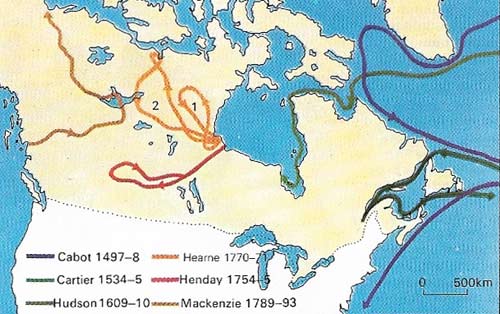
Figure 1. Recorded European exploration of Canada began with Cabot exploring the eastern coast and Cartier the St Lawrence River. Henry Hudson (d. 1611) in 1610 entered the great bay that bears his name. Samuel Hearne (1745–1792) was the first white man to go overland from Hudson Bay to the Arctic Ocean. Anthony Henday reached the Rocky Mountains and Alexander Mackenzie (1755–1820) crossed to the Pacific coast in 1793.
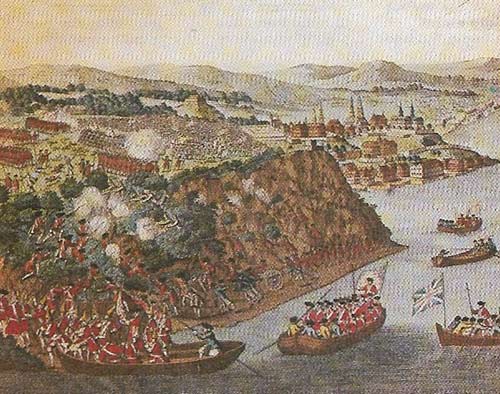
Figure 2. The capture of Quebec in 1759 by Major-General James Wolfe (1727–1759) led to the defeat of France and bolstered the British position in North America. Wolfe was only 32 when given command of an expedition to attack Quebec from the St Lawrence and gain it for Britain. He laid siege to the town in June but an assault in July failed. Yet on the night of 12 September, British boats eluded the notice of the French sentries and more than 4,000 of Wolfe's men were able to scale the bluff overlooking the river to meet the French in battle next day on the plains of Abraham. The contest was short and savage, and both Wolfe and the French commander, General Louis Montcalm (1712–1759), were mortally wounded.
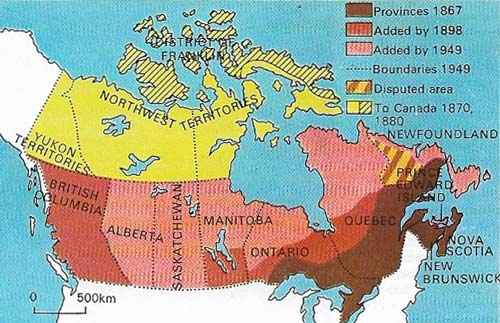
Figure 3. Canada came into being in 1867 with the union of Upper Canada (Ontario), Lower Canada (Quebec), Nova Scotia and New Brunswick. The western lands, bought from the Hudson's Bay Company, were organized as the North-West Territory and governed from Ottawa. Saskatchewan and Alberta were later created out of it. Newfoundland was more attached to Britain than to Canada and stayed separate until 1949.

Figure 4. The Canadian Pacific Railway, completed in 1885, linked Montreal and Vancouver, quickened settlement and development in the west and helped to instill a spirit of national unity, a stupendous feat by any standards, the line was built by a private firm aided by bank loans and government land grants.

Figure 5. Fewer than 500,000 people lived in the British North American colonies in 1815, yet by 1850 the populations boosted by immigrants topped 2 million. By 1971 it had reached 21.5 million, of which 18.2 million were Canadian-born, including (270,000 native Americans, 17,500 Inuit). Those born in Britain numbered 933,000.

Figure 6. Canada was the sixth largest trading nation in the world in 1971 but her pattern of trade changed dramatically during the century. In 1900 more than 50 percent of exports went to Britain and only 38 percent to the United States. By the mid-1970s 70 percent went to the United States and 7 percent to Britain. Japan and other EEC countries took as much as Britain. The United States supplies 70 percent of Canada's imports; no other nation provides more than 5 percent. The largest export earners for Canada are newsprint, wheat, lumber, wood pulp, nickel, aluminum, petroleum, iron ore and copper. Major import items include machinery, car parts, electrical goods, cars, and tractors.
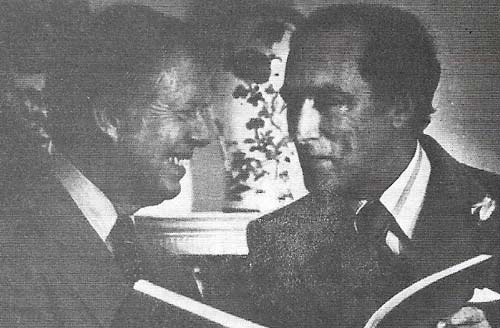
Figure 7. Pierre Trudeau (1919–2000) (right) addressed Congress during his visit to the United States in February 1977. It was an historic occasion: never before had a Canadian Prime Minister been invited to speak before both houses of Congress in assembly. Trudeau was able to assure his audience that he was implacably opposed to Quebec's secession, and that as a long as the Canadian people desired it, the unity of the confederation would remain unimpaired. Trudeau's trip took place just one month after the inauguration of US President Jimmy Carter (1924–) (left) and the leaders discussed Canadian-American matters and broader world issues.
Indigenous peoples inhabited Canada for thousands of years before the first Europeans set foot on its soil. The Indians, migrant from Asia perhaps 20,000 years ago, hunted and fished the vastness of the continent. In the Arctic region the life of the Inuit, a branch of the same stock, revolved around seals, from which they obtain food, clothing, light, and heat. These were the first human inhabitants, and the name of Canada itself comes from the Huron-Iroquois word Kanata which Jacques Cartier (1492–1557) noted during his explorations of 1534–1535 (Figure 1).
The French influence
About AD 1000 the Vikings became the first Europeans to land in Canada. Little is known about these forays and some 500 years elapsed before details of frequent European contact began to be recorded. In 1497 John Cabot (c. 1450–c. 1500) under English patronage explored Newfoundland's coastline. He was followed by Cartier, who explored the mouth of the St Lawrence River in 1534 and set up the first French settlements, but it was not until after 1600 that permanent bases were established. Samuel de Champlain (1567–1635) founded a base at Port Royal (present-day Annapolis, Nova Scotia) in 1605 and built a fort at Quebec three years later, thus laying the foundations for French settlement of what was known as New France. The new colony, however, was troubled by Indians and British settlers.
The rivalry between Britain and France in Europe and the Caribbean was also evident in North America, where both had colonies and trading posts. The contest came to a head during the Seven Years War (1756–1763). The British wrested Quebec (Figure 2) and then Montreal from the French whose position in the continent rapidly worsened. The Peace of Paris (1763) ratified the cession of all France's North American possessions east of the Mississippi, except for Louisiana.
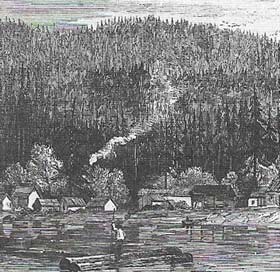 |
| Hudson Bay was the first site of the company that dominated the early economy of Canada. Founded in 1670, the Hudson's Bay Company had a charter from King Charles II (r. 1660–1685) to seek a northwest passage to Asia, occupy land around the bay and trade with Indians. The company made huge profits in furs and also served as an outpost of the British Empire, extending its sway throughout the Canadian northwest. |
Although the former French colonies now became British possessions, the French-speaking people of Quebec were allowed to keep their Roman Catholic religion and French civil law. British loyalists had flooded northwards during the American Revolution (1776–1783) and in an attempt to avoid further friction between the two communities the British in 1791 created Upper Canada (present-day Ontario) and Lower Canada (present-day Quebec). Upper Canada was predominantly British, Lower Canada predominantly French.
The road to federation
Politically Canada resulted from a shotgun marriage of English-speaking and French-speaking settlers, but the English were more numerous and had the ear of the British governors. Furthermore, the 19th century saw a great influx of immigrants, most of whom came from Britain and the United States; few came from France.
Uprisings in Upper and Lower Canada in 1837 reflected social tension and growing frustration at the restrictions imposed by a system of government with officials appointed for life. Chosen to investigate, Lord Durham (1792–1840) recommended the granting of self-government in local matters and that Upper and Lower Canada be reunited, a union effected in 1840. Eventually, in 1867 the British North American Act set up a federal structure for the new nation (Figure 3) that was to enjoy a large measure of self-government and dominion status.
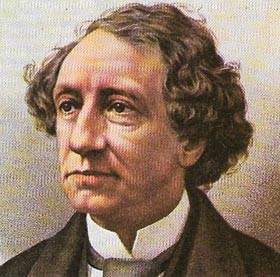 |
| John A. Macdonald (1815–1891) first prime minister of federal Canada, is regarded as its architect. Born in Scotland, he combined a strong sense of nationhood with political opportunism. He survived a major scandal over receiving campaign funds from a railway contractor to win the 1878 election. He campaigned for a "national policy" of protection for industry by opposing high tariffs, a transcontinental railway and systematic development of the Canadian west. |
The growth of nationhood
In the 20th century, Canada came to take an independent stance in international affairs. Recurrent fears of annexation by the United States had been an early spur to the evolution of a distinctive identity. The policies of such prime ministers as Wilfrid Laurier (1841–1919), Robert L. Borden (1854–1937), William Lyon Mackenzie King (1874–1950), Louis St Laurent (1882–1973), and Lester Pearson (1897–1972) were in sympathy with this development.
Canada was the first of the British colonies to assert its claim to full independence this century. In 1919 Canadians were forbidden to accept British titles; in the 1920s Canada opened its first diplomatic post abroad; when asked by Britain to send troops to Chanak in 1922, Mackenzie King refused to do so without first consulting parliament; Canada delayed its entry into World War II to stress the independent nature of the decision; and appeals to the Privy Council in Britain were brought to an end in the 1940s.
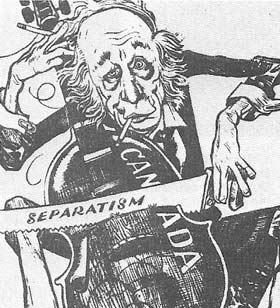 |
| A major diplomatic crisis developed when President de Gaulle (1890–1970) of France raised the issue of separatism within Canada in 1967. On a visit to Montreal, he addressed a crowd with the slogan: "Vive Le Quebec libre". This delighted supporters of the separatist parties, but the government and many more Canadians were simply affronted. In this satirical view of the separation issue, the Parti Quebecois leader, Rene Levesque, is depicted using separatism as a saw cutting through Canada. |
There has been a positive dimension to Canada's participation in world affairs. Canada was a founder member of the United Nations (1945) and the North Atlantic Treaty Organization (1949), and Prime Minister Pearson inspired the idea of a UN peacekeeping force in Suez in the mid 1950s. Canada established diplomatic links with communist China in 1971, before most nations, and in July 1976 became the wealthiest non-member country to sign a trade agreement with the European Economic Community.
Domestically indigenous agitation since 1945 for social and political recognition has led to a number of much-needed reforms including granting the vote to all Indians in 1960. In 1976 the victory of the Parti Quebecois in Quebec's provincial elections brought to power a party with an avowedly separatist leadership. The possibility that Quebec may yet secede presents the most significant constitutional challenge to the federation since it was formed more than a century ago.
